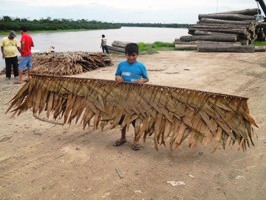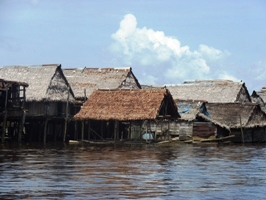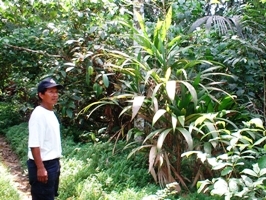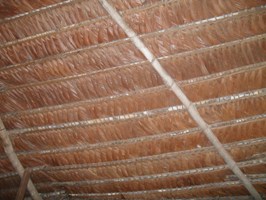Olimpio Petit works hard. All through the night he docks his river boat, the Rey San Pedro, at tiny villages along the Amazon River and takes on rice, pigs, people, and more often than not scores if not hundreds of large palm mats.
At daybreak I make my way by plank to the shore and look back at the Rey and see those mats piled high on the roof. The Rey is looking less like a cargo boat and more like a beast of burden
The palm mats that Senor Petit transports are call crisnejas. Woven from a thatch palm the crisnejas are the basic building unit for countless roofs in the Amazon Basin.
Besides keeping out the rain a thatch roof can provide insulation from the tropical sun far better than sheet metal.
Also, I’ve noticed a crisnejas roof is a lively ecosystem of rats, bats, birds, and bugs all intent on crapping on my sleeping hammock. I’ve heard stories of kids handy with blowguns lying in their hammocks and taking rats making their way through the thatch.
Aside from the menagerie, another downside is that a crisnejas roof will only last about 5 years. Repairing is difficult so the whole roof is torn off and replaced.
Women in the small villages construct the crisnejas starting with a 3-meter backbone of pona palm, Socratea exorrhiza, a tough, flexible wood providing everything from flooring to hunting bows.
The women weave leaves from the irapay palm onto the pona backbone. The irapay palm, Lepidocaryum tessmannii, is a head-high palm with ordinary oval leaves that are perfect for thatch roofs.
The result is a row of irapay leaves interwoven and hanging flag-like by their stems. A good crisnejas will have nearly a hundred leaves hanging from its slat. Unscrupulous types try to pass off thatch with half that amount—junk hardly good for a chicken coup.
With a good crisnejas the stems are interwoven each holding its neighbors fast and the odd leaves overlapping the even giving a delightful woven effect.
This is not easy work. With stems from the irapay palm green and tough, a lifetime of twisting them onto pona slats makes fingers like cable.

No manner how good the crisnejas they must be expertly placed on the roof. Builders prefer a steep roof, the peak meeting at a right angle–roofers 12-12 pitch. Anything flatter will invite leaks, besides the high peak will aid in cooling.
With rafters in place, the crisnejas are put on like shingles the world over—the first course is put on at the bottom and subsequent courses then overlap the proceeding. Here in eastern Peru the crisnejas are fastened to the rafters with a vine. Probably “Huambe”, Philodendron solimoesense.
The crisnejas must overlap well, and that’s easy to check. From the inside one should see no more than 6 inches between the pona slats. That will insure enough overlap to keep out the rain. If the odd leak happens, it’s is often fixed by a jab with a stick to the troublesome area. With a little luck the leaves will rearrange and the leak will stop.
If you’re planning a zoological display you might consider using crisnejas for thatching or general background motif. I can ship up crisnejas through New Orleans. I’ll probably need fumigation papers to get through US Customs, but I usually need those anyway for plant materials.
John Waymire



